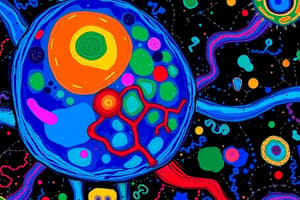Podcast
Questions and Answers
Which statement accurately describes the role of mitochondria in a cell?
Which statement accurately describes the role of mitochondria in a cell?
- Involved in protein packaging and secretion
- Site of lipid synthesis
- Powerhouse of the cell, site of ATP production (correct)
- Location where genetic material is stored
Which enzyme condition is likely to result in denaturation?
Which enzyme condition is likely to result in denaturation?
- Extreme temperature changes (correct)
- Optimal pH
- Moderate enzyme activity
- Increased substrate concentration
What is the primary function of the Golgi apparatus in a eukaryotic cell?
What is the primary function of the Golgi apparatus in a eukaryotic cell?
- Regulates substance entry and exit
- Modifies and packages proteins for secretion (correct)
- Digests waste materials
- Synthesizes lipids
What is the process by which gametes are produced?
What is the process by which gametes are produced?
Which of the following accurately describes catabolism?
Which of the following accurately describes catabolism?
Which statement about enzyme activity is true?
Which statement about enzyme activity is true?
What characterizes asexual reproduction?
What characterizes asexual reproduction?
Which feature is crucial for maintaining homeostasis in living organisms?
Which feature is crucial for maintaining homeostasis in living organisms?
Flashcards are hidden until you start studying
Study Notes
Cell Biology
- Cell Structure:
- Prokaryotic cells: simple structure, no nucleus (e.g., bacteria).
- Eukaryotic cells: complex structure, contain a nucleus (e.g., plants, animals).
- Cell Organelles:
- Nucleus: holds genetic material (DNA).
- Mitochondria: powerhouse of the cell, site of ATP production.
- Endoplasmic Reticulum (ER): Rough ER synthesizes proteins; Smooth ER synthesizes lipids.
- Golgi Apparatus: modifies and packages proteins for secretion.
- Lysosomes: contain enzymes for digestion of waste.
- Cell Membrane: selective barrier, controls substance entry/exit.
- Cell Division:
- Mitosis: produces two identical daughter cells, used for growth and repair.
- Meiosis: produces gametes (sperm and egg cells), involves two rounds of division.
Enzymes
- Definition: Biological catalysts that speed up chemical reactions without being consumed.
- Structure:
- Made of proteins, can be affected by temperature and pH.
- Active site: region where substrate binds.
- Mechanism:
- Lower activation energy, enabling reactions to occur at lower temperatures.
- Enzyme-substrate complex: temporary formation during the reaction.
- Factors affecting enzyme activity:
- Temperature: each enzyme has an optimal temperature; high temperatures can denature enzymes.
- pH: each enzyme has an optimal pH; deviations can affect activity.
- Substrate concentration: increasing concentration can enhance reaction rate up to a limit (saturation).
Life Processes
- Metabolism:
- Catabolism: breakdown of molecules to obtain energy (e.g., cellular respiration).
- Anabolism: synthesis of complex molecules from simpler ones (e.g., protein synthesis).
- Homeostasis:
- Maintenance of stable internal conditions (e.g., temperature, pH, hydration).
- Reproduction:
- Asexual reproduction: single organism reproduces (e.g., binary fission in bacteria).
- Sexual reproduction: involves two parents, genetic variation (e.g., fertilization).
- Growth and Development:
- Organisms grow and develop through cellular division and differentiation.
- Response to Stimuli:
- Ability to respond to environmental changes (e.g., light, temperature) through mechanisms like movement and behavior.
Cell Structure
- Prokaryotic cells lack a nucleus and other membrane-bound organelles, while eukaryotic cells have a nucleus and complex internal compartments.
- Nucleus contains the cell's genetic material (DNA), controlling cellular activities.
- Mitochondria are responsible for energy production through cellular respiration, generating ATP.
- Endoplasmic Reticulum (ER) is a network of interconnected membranes. Rough ER synthesizes proteins, while Smooth ER synthesizes lipids and detoxifies harmful substances.
- Golgi apparatus modifies, packages, and sorts proteins for secretion or delivery to other organelles.
- Lysosomes contain digestive enzymes that breakdown cellular waste and foreign materials.
- Cell membrane acts as a barrier, regulating the passage of substances into and out of the cell.
Cell Division
- Mitosis is a process that produces two identical daughter cells, essential for growth and repair.
- Meiosis results in the production of four genetically unique gametes (sperm and egg cells), crucial for sexual reproduction.
Enzymes
- Enzymes accelerate chemical reactions by lowering the activation energy without being consumed in the process.
- Enzymes are typically proteins with a specific active site where the substrate binds.
- The interaction between an enzyme and its substrate forms an enzyme-substrate complex, facilitating the reaction.
- Temperature and pH significantly affect enzyme activity, with each enzyme having an optimal range.
- Substrate concentration can increase reaction rate until saturation is reached.
Life Processes
- Metabolism encompasses all chemical reactions occurring within an organism.
- Catabolism breaks down complex molecules into simpler ones, releasing energy.
- Anabolism builds complex molecules from simpler ones, requiring energy.
- Homeostasis refers to the maintenance of stable internal conditions despite external changes.
- Reproduction can be asexual, involving a single parent, or sexual, requiring two parents.
- Growth and development involve cell division and differentiation, leading to increased size and complexity.
- Response to Stimuli is the ability of organisms to detect and react to environmental changes.
Studying That Suits You
Use AI to generate personalized quizzes and flashcards to suit your learning preferences.




